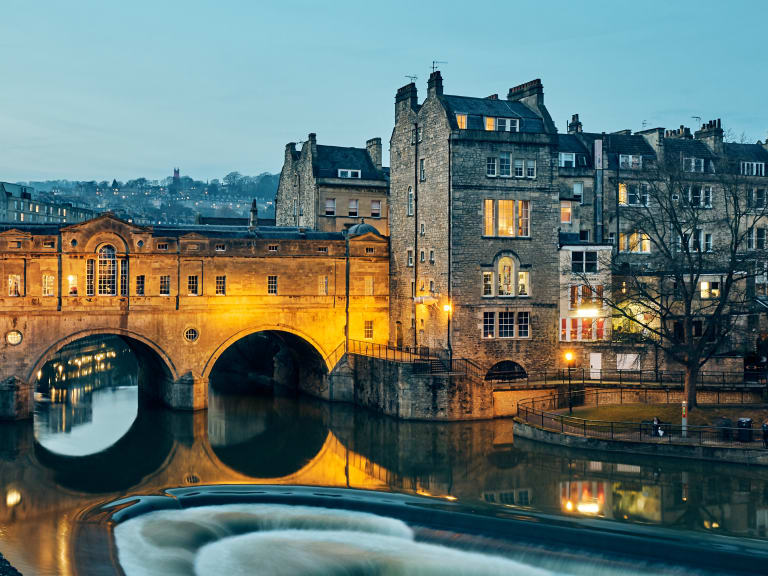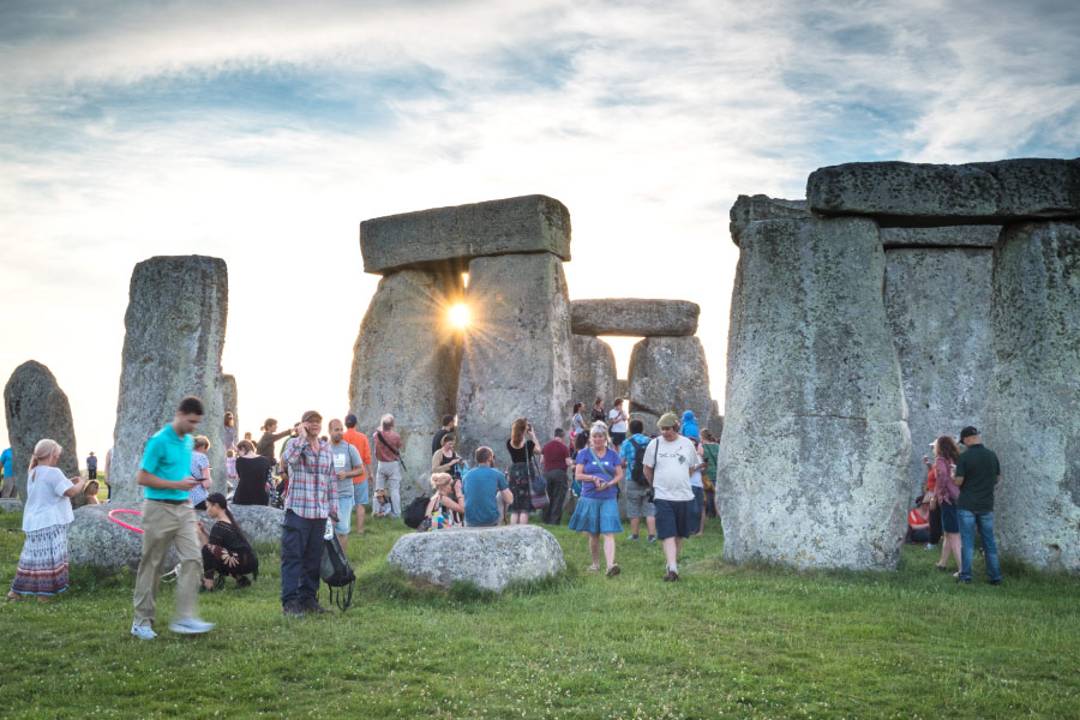More about: 10 Things to Do near Stonehenge
No one doubts that Stonehenge should be on the list of places to see when traveling to London. However, there are many other nearby attractions that are also worth a visit, from other prehistoric remains to towns and cities of great interest.
If you have time to spare, I recommend getting a map of the area where Stonehenge is located, which has been declared a World Heritage Site. With that information, try to approach places like Salisbury, the Neolithic remains of Avebury, Lacock or Old Sarum, among others.
1. Discover the world's largest stone circle at Avebury

Only half an hour separates the Stonehenge monument from this World Heritage village. The beautiful town of Avebury is known for the largest stone circle in the world, its ancient tombs and other remains from the Neolithic and Bronze Age.
The remains are located within the village and can be visited every day of the year. In addition to the stone circle, the largest Neolithic tomb in Britain, the nearby avenue and Silbury Hill, the largest artificial hill in Europe, are also of great interest. All this makes it not detract in any way from the best tours that can be done in London.
If you are already a bit tired of archaeological remains, Avebury is still worthwhile. There you can visit:
- The Church of St. James, erected in 1000 AD, and which you can enter for free.
- Avebury Manor, whose gardens are a must for those who have already enjoyed the London parks.
How to get to Avebury
The most convenient way to get there is to book the tour to Avebury in advance because you can also visit other incredible villages in the area, always accompanied by a local expert guide, which will make you learn about the place and will avoid headaches in the preparations.
Anyway, besides being able to get there by car (about 2 hours drive), Avebury is well connected by train from London. So, you will have to take a train from Paddington station (there is a tube stop with the same name and here you can see how to get around the London Underground ) to Swindon and there look for the bus number 49.
2. Walk around Avebury

If you have had the good idea to visit Avebury, you should try to make the most of its charms. This is, in short, the same as you do in the British capital when you can visit some of London's secret places, beyond the best-known attractions. Thus, you can calculate that the visit to the stone circle and the museum can take you about an hour and a half. The rest of the time, you can:
- Go see the mansions I mentioned earlier.
- Discover some lesser known places, but just as interesting as Windmill Hill, one of the oldest sites in the area. It is thought to have been built around 3675 B.C. and was a meeting place for festivals and exchanges. Over time, several burial mounds worth visiting were built on the same elevated site.
- The aforementioned Silbury Hill, which is an artificial hill that is considered one of the most mysterious prehistoric remains of the country and its 30 meters high make it the largest mound made in Europe.
How to get around Avebury
Actually, the best way to visit the area around Avebury is by walking. Although there is a parking lot next to Silbury Hill, my recommendation is that you try to get there on foot, as well as the rest of the attractions in the town.
3. Stroll around Lacock

Lacock is one of the most picturesque villages in the whole area and, in fact, it is protected by the National Trust, an institution dedicated to ensuring that England's places of historical and natural interest are not damaged. You may have already seen some images of it, because it was one of the locations of the Harry Potter movies. It is, therefore, a good complement to visiting Harry Potter related places in London.
The village is located in the north of the county of Wiltshire, relatively close to Bath. Its origin dates back to the eleventh century, although its importance grew two centuries later when the nearby abbey was founded.
Strolling through its streets is the best way to immerse yourself in the typical rural architecture of the south of the country, which mixes stone facades with other white and timber-framed. Although these walks alone make up for a visit to the village, you can always complete the excursion with a visit to one of its churches, such as the church of San Ciriaco.
How to get to Lacock
If you are in Bath or you arrive there from London it will be quite easy to reach Lacock, since it is only a half hour drive away. In that case, I recommend you to leave your car in the parking lot at the entrance of the village and visit its attractions on foot.
In case you want to arrive by public transport you will find several possibilities:
- Train London-Chippenham and bus to Lacock.
- Train to Bath and bus to Lacock.
4. Enjoy the beauty of Bath

Like other towns I have talked about, Bath was also declared a UNESCO World Heritage Site. The city is mainly known for its Roman baths, built more than 2000 years ago. For this, they took advantage of the thermal waters present in the area.
Although it was the Romans who began to use these baths, in the eighteenth century the city became the meeting point among the London elite who sought to take advantage of the properties of the thermal waters.
Other attractions you can visit in the city and why there are excursions to Stonehenge and Bath from London that combine both cities are:
- Pulteney Bridge.
- Prior Park.
- Bath Abbey.
- Several interesting museums.
How to get to Bath
From London Paddington station in London there is a fast train that travels the journey in just 1 hour and 30 minutes. If you prefer another option, there is a normal train that leaves from Waterloo and takes an hour more to get to Bath.
The National Express bus company has a regular line that connects London Victoria Station with the city of Bath, but the journey takes 3 hours. Of course, the price is much lower.
Finally, Bath is part of many =organized tours from London, which you can book in advance here. This is the best option if you want to combine the visit with Stonehenge.
5. Don't miss Salisbury and its impressive cathedral

As you may have seen in my article on how to get to Stonehenge from London, almost all public transport requires a transfer in Salisbury and it is also included in some of the organized tours that depart from the capital. No matter how you arrive, this city offers great attractions to spend a few hours wandering through its streets and discovering some of its most emblematic corners.
Although the walk through the streets of this medieval city, already make the visit worthwhile, you should know that:
- The great attraction of Salisbury is its magnificent Cathedral of the Blessed Virgin Mary. This building began to be built in the early thirteenth century and inside is preserved the English Magna Carta.
- It is also worth stopping at the Salisbury Museum, where part of its exhibition is related to Stonehenge, making it a perfect place to delve into the history of the monument.
- Finally, if you are a fan of country pubs you should not leave Salisbury without entering the Haunch of Venison. This place, opened as far back as 1320, has nothing to envy to those you can find in the London nightlife, to the point that its visit is recommended by the prestigious National Inventory of Historic Pub Interiors.
Joaquín's Traveller Tip
From Salisbury it is quite easy to reach the megalithic monument of Stonehenge. Just look for the bus called The Stonehenge Tour Bus.
How to get to Salisbury
- Salisbury train station is well connected to London and it is easy to get to Salisbury. Trains run very frequently from Waterloo Station in the capital and it takes about an hour and a half to get there.
- Another option to go from London to Salisbury is the bus and, in fact, there is a direct one from Heathrow Airport itself. If you have decided to go by car, the journey takes about 2 hours.
- Finally, the most convenient option is to hire an organized tour from London to Stonehenge, such as the one that allows you to visit Stonehenge, Bath and Salisbury in the same day.
6. Immerse yourself in the past at Old Sarum

A mere 14 kilometers from Stonehenge, history buffs can visit the hill of Old Sarum, considered to be the birthplace of neighboring Salisbury.
Old Sarum was first occupied by hunting parties and later inhabited by some of the earliest farmers. A fortress was built in this location during the Iron Age and, in time, witnessed the passage of Romans, Normans and Saxons. In total, 5000 years of human history.
The site, located on the hill itself, is now part of the English Heritage Association and is open to the public to visit. It requires the purchase of a ticket.
How to get to Old Sarum
Being located only about 2 miles from Salisbury, it can be reached on foot from the city. Just head north and take the opportunity to see the banks of the River Avon and part of Victoria Park and Hudson's Field.
7. Get to know Amesbury

The closest town geographically to Stonehenge is Amesbury, so much so that many include it among the things to see when approaching the monument. This small town was founded in 976, although there is evidence that the area was inhabited some 10,000 years ago.
Amesbury is also known for its connection to the myth of King Arthur. There, in a convent, was where Queen Guinevere took refuge after the death of the king at Camlann. Near this locality was found one of the most luxurious cemeteries of the Bronze Age, where the remains of two men (possibly nobles of the time) were found with more than 100 objects around them, such as gold earrings or copper knives. One of them is known by the nickname of "King of Stonehenge".
Walking through the vicinity of the town you can enjoy a unique view of the Avon River until you reach the jewel in the crown of Amesbury: its ancient abbey, now converted into the Church of St. Mary and St. Melor. The building dates back to the 10th century and was the burial place of Eleanor of Provence, wife of Henry III.
How to get to Amesbury
Although the most convenient is to join one of the tours that go from London to Stonehenge, you also have the option of going on one of the buses of the National Express company.
You can also get there easily from Salisbury, as you only have to take one of the buses that link this town with Stonehenge.
8. Delve into history at Durrington and Woodhenge

Just 3 kilometers from Stonehenge is Woodhenge, a Neolithic wooden monument dated around 2500 BC, that is, practically contemporary to the monument.
Woodhenge consisted of six vertical pole ovals, which were surrounded by a ditch and a bank. The structure was built in such a way that it aligned with the sunrise during the summer solstice at Stonehenge. This wooden monument is now part of the Stonehenge and Avebury World Heritage Site, as is the nearby South Circle of Durrington Walls.
It is aligned with the sunrise at the winter solstice (another of the best times to visit Stonehenge), so it is thought to have been complementary to that of Woodhenge. It is known that many people came to Durrington for winter celebrations even before the wooden structure was erected.
How to get to Durrington and Woodhenge
Both monuments can be visited very easily from Amesbury or Stonehenge, without the need to find any transportation.
9. Discover Castle Combe, England's prettiest village

Castle Combe is recognized by many as the most beautiful village in England. It is a very small town, with only about 350 inhabitants in which reigns a tranquility only broken by visitors who come to see it.
The village consists of only one main street, but the beauty of its buildings will make you want to photograph them one by one. Its location, in the middle of wooded hills, also contributes greatly to give it a magical atmosphere.
As for the places you should visit during your visit, the following stand out:
- The small St. Andrew's Church, with a history dating back to at least the 13th century.
- The White Hart, a pub that has been open for more than five centuries.
- The Market Cross, in the market square.
- The village also has a five-star hotel(Manor House Hotel) with a Michelin-starred restaurant. This hotel is housed in a 14th century building and its gardens cover more than 140 hectares.
Getting to Castle Combe
One of the attractions of the village is being away from major transport routes. This, which has allowed its streets to be preserved with little change, makes it not easy to get to visit.
The best way to get there if you do not have a car is to take the train from London to Chippenham, which is about 5 miles away, or to Bath, about 10 miles away. From both cities you can take a cab or, if you are in Chippenham, a bus.
10. Prehistoric, medieval and industrial times in Devizes

It is hard to believe that such a small town has more than 500 buildings listed for their historical or artistic interest. This town, Devizes, is home to everything from Neolithic remains to buildings from the industrial era, including a medieval layer that can be seen in all its streets.
To begin with, Devizes is one of the most important centers for learning about the history of Stonehenge and the rest of the sites in the area, as it is home to the Wiltshire Museum, which exhibits all kinds of objects found in the various excavations carried out at Stonehenge and Avebury. Likewise, there are also those from Bush Barrow.
Once outside the museum, it is essential:
- Stroll through the Market Place, a crescent-shaped space where a large open-air market is held every Thursday. From that same square you can see the village brewery, crowned by a Victorian tower.
- To approach to see the town hall of neoclassical style, in addition to the different Georgian houses.
- In the surroundings is one of the most impressive works of the beginning of the industrial era: the Kennet and Avon Canal.
How to get to Devizes
From London there are plenty of buses to get to Devizes. Here you can find the timetables. There is currently no train stop in the town.




